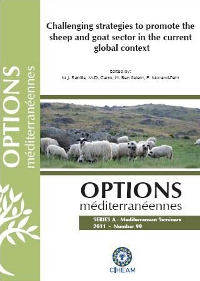| Article précédent | p. 245-249 | Article suivant |
Nutritive value and essential oils characterization of Rosmarinus officinalis and Thymus capitatus from the central region of Tunisia
Rosmarinus officinalis (rosemary) and Thymus capitatus (thyme) leaves and twigs were collected from the central region of Tunisia in March and April 2008. Samples were immediately stored at -10°C. Chemical composition and in vitro gas production parameters were determined. Essential oils (EO) from the two species were extracted by steam distillation and analyzed using gas chromatography (FID), followed by a Carbon-13 NMR spectroscopy procedure to confirm the major compound structures. Rosemary and thyme were both low in crude protein (58 and 88 g/kg DM, respectively). The ADF content was similar and close 313 g/kg DM in both plant species, whereas the lignin content in thyme was higher than in rosemary (226 and 167 g/kg DM, respectively). Rosemary showed lower in vitro asymptotic gas production than thyme (27.7 vs 49.6 ml). In vitro organic matter digestibility after 24 h of incubation (IVOMD24h) and metabolisable energy (ME) estimated from the chemical composition and gas production followed a similar pattern than that of in vitro fermentation parameters. Extracted EO content in rosemary was approximatively the double of that determined in thyme (0.43 and 0.25 percent of DM, respectively). Thyme EO was found to be high in the active monoterpen phenol carvacrol (70 percent), which is the chemotype of thyme. Other secondary compounds detected in thyme were -caryophyllen (8.5 percent), -terpinen (4.3 percent) and p-cymen (3.8 percent). On the other hand, major compounds identified in rosemary EO were 1-8 cineol (44.2 percent), camphor (12 percent) and -pinen (11.6 percent). It was concluded that both native medicinal plant species would be of low nutritive value if pastured by sheep and/or goat. The EO chemotypes detected, mainly carvacrol and 1-8 cineol could be envisaged as potential additives to manipulate rumen fermentation to improve feed efficiency in ruminants and/or as a chemical tracers for trazability of meat produced from grazing sheep and goat.
Les feuilles et brindilles de Rosmarinus officinalis (romarin) et Thymus capitatus (thym) ont été collectées dans une région du centre de la Tunisie en mars et avril 2008. Les échantillons ont été immédiatement stockés à -10°C. La composition chimique et les paramètres in vitro de la production de gaz ont été déterminés. Les huiles essentielles (HE) des deux espèces ont été extraites par distillation et analysées en utilisant la chromatographie en phase gazeuse (FID), suivie d'un procédé de spectroscopie au Carbon-13 NMR pour confirmer les structures des composés principaux. Le romarin et le thym étaient pauvres en protéine brute (MAT : 58 et 88 g/kg MS, respectivement). Les teneurs en ADF étaient très proches dans les deux espèces (en moyenne 313 g/kg MS), Cependant, le degré de lignification était plus élevé dans le cas du thym que dans celui du romarin (ADF : 226 et 167 g/kg DM, respectivement). Le romarin a montré une plus basse production asymptotique de gaz que le thym (b : 27,7 et 49,6 ml, respectivement). La digestibilité in vitro de la matière organique après 24 h (DIVMO24h) d'incubation et l'énergie métabolisable (EM) estimées à partir de la production de gaz et de la composition chimique ont suivi une tendance semblable à celle des paramètres in vitro de fermentation. La teneur en HE dans le romarin était approximativement le double de celle déterminée dans le thym (0,43 et 0,25 pour cent de MS, respectivement). Les HE du thym se sont avérés riche en carvacrol (70 pour cent), qui est le chimiotype de l'espèce. Les autres composés secondaires détectés dans le thym sont le -caryophyllene (8,5 pour cent), le -terpinene (4,3 pour cent) et le p-cymen (3,8 pour cent). D'autre part, les composés principaux identifiés dans les HE du romarin étaient le cineol 1-8 (44,2 pour cent), le camphre (12 pour cent) et le -pinene (11,6 pour cent). En conclusion, les deux espèces médicinales natives étaient d'une faible valeur nutritive pour les petits ruminants en pâturage. Les chémotypes des HE détectés, principalement le carvacrol et le cineol 1-8 peuvent être envisagés en tant qu'additifs potentiels pour manipuler les fermentations ruminales et améliorer l'efficacité d'alimentation chez les ruminants et/ou comme traceurs chimiques pour la traçabilité de la viande produite à partir de ovins et des caprins sur parcours naturels.
- [ Afficher ]
- [ Télécharger ]
- [ Exporter la citation ]
Vous pouvez télécharger la citation au format :
- [ Imprimer ]
-
Mots-clés
COMPOSITION CHIMIQUE, HUILE ESSENTIELLE, VALEUR NUTRITIVE, ROSMARINUS OFFICINALIS, THYMUS (GENRE)Citer cet article
Moujahed N., Bouaziz Y., Ben Jannet A., Ghrabi Z. Nutritive value and essential oils characterization of Rosmarinus officinalis and Thymus capitatus from the central region of Tunisia. In : Ranilla M.J. (ed.), Carro M.D. (ed.), Ben Salem H. (ed.), Morand-Fehr P. (ed.). Challenging strategies to promote the sheep and goat sector in the current global context. Zaragoza : CIHEAM / CSIC / Universidad de León / FAO, 2011. p. 245-249. (Options Méditerranéennes : Série A. Séminaires Méditerranéens; n. 99). 13. International Seminar of the Sub-Network on Nutrition of the FAO-CIHEAM Inter-Regional Cooperative Research and Development Network on Sheep and Goats, 2009/10/14-16, León (Spain). http://om.ciheam.org/om/pdf/a99/00801564.pdf



